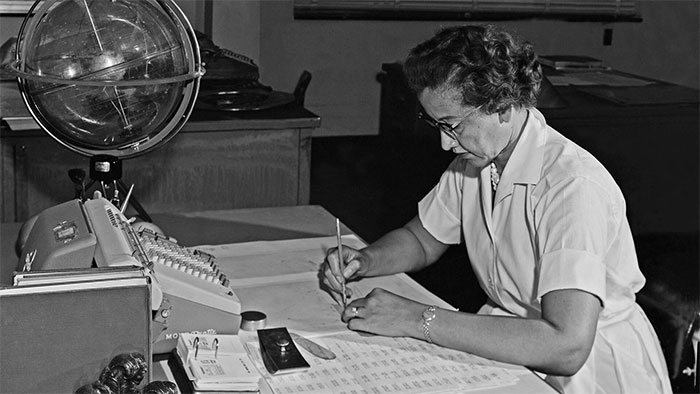4 lifetime contributions of 'silent heroine' at NASA
The eminent mathematician Katherine Johnson of America passed away on February 24, 2020, aged 101. Her silent work received little attention until she was awarded the Presidential Medal.
The contributions of mathematician Katherine Johnson
- Mercury-Redstone Flight 3
- Drafting technical documents
- Mercury-Atlas Flight 6
- Apollo 11 flight
During 33 years working for the US space and space agency (NASA), mathematician - physicist - space engineer Katherine Johnson has contributed to many of NASA's successful space missions by calculating formulas. His math, including four important scientific contributions.

Mathematician Katherine Johnson worked at NASA's Langley Research Center in 1962 - (Image: NASA).
Mercury-Redstone Flight 3
Mathematician Katherine Johnson has worked at the Langley Research Center of the National Aviation Advisory Committee (NACA - the predecessor agency of NASA) since 1953.
On May 5, 1961, NASA flew Mercury-Redstone 3, the first manned space mission within the Mercury program.
The name of the astronaut Alan Sheppard - the flight controller associated with this historic event. But besides that, Katherine Johnson has contributed to the success of the flight with the work of calculating the launch trajectory.
Drafting technical documents
In 1960, Katherine Johnson and scientist Ted Skopinski drafted a document on satellite retrieval.
The document, called 36-page D-233 Technical Note, is 36 pages thick, describing by equations the stages of a flight into space, including the location necessary for a successful spacecraft landing.
This document was used as a reference in the historic flights of two astronauts Alan Sheppard in 1961 and John Glenn in 1962.

Mathematician Katherine Johnson received the Presidential Medal of Freedom from President Barack Obama at the White House on November 24, 2015 - (Image: REUTERS)
Mercury-Atlas Flight 6
On February 20, 1962, within the flight of Mercury-Atlas 6 and Mercury-Atlas 6, NASA launched the Friendship 7 spacecraft into orbit. This is the third manned space mission in the Mercury program.
This is also the first time an American astronaut (John Glenn) has successfully completed a full flight around the Earth's orbit (the previous two flights did not complete an orbit).
During this historic flight, mathematician Katherine Johnson was in charge of manually checking the orbital tracking program. Orbit flights must be supported by orbital monitoring programs. Computers have been programmed to control the spacecraft's flight path.
Astronaut John Gleen suspects that the orbital tracking program should ask mathematician Katherine Johnson to redo the calculations manually and he only agrees to control the flight if the calculations match the calculations from the machine. count. It took a day and a half for the mathematician to check the calculations.
Apollo 11 flight
More than 50 years ago on July 20, 1969, the American space shuttle Apollo 11 brought the first astronauts to set foot on the moon.
Under the earth, mathematician Katherine Johnson has contributed to the successful flight by calculations that allow synchronization between the lunar module (the module that landed on the moon) with the command and service mode of the Apollo ship astronauts.
Ms. Katherine Johnson has retired since 1986. During her career, she has drafted 26 research reports.
Her quiet work at NASA received little attention until she was awarded the Presidential Medal of Freedom by President Barack Obama in 2015, America's highest civilian medal.
She was also one of the first African-American women to break gender and skin barriers to work at NASA.
In 2016, her life and career were featured in the movie "Hidden Figures" about three African American mathematicians.
The film is adapted from the book of the same name by female writer Margot Lee Shetterly (also African-American), which was screened in Vietnam in 2017 under the title "Superior trio".
- Five years from now, there will be a lifetime flu vaccine
- America launches 'The unbeatable eagle' is the new version of the Su-35S that is able to fight against Russia
- Edith Cavell and the most famous story of World War I
- The sun was silent
- Vietnam ranked 89/125 on scientific and technological contributions
- The sun is the most gentle in 100 years and the risk of forming a mini ice age
- Carbon Monoxide - silent killer
- Jeanne d's relic 'Arc is a piece of Egyptian mummy?
- The heartbreaking truth behind the photo of vultures waiting to eat the baby
- Add American evidence never to the Moon
- The most convenient
- If you're an astronomer, don't ignore these 5 NASA sites
 The most famous scientific failures in history
The most famous scientific failures in history Mysterious genius mechanic and the machine froze time
Mysterious genius mechanic and the machine froze time The son carries the 'bad gene' of genius Albert Einstein
The son carries the 'bad gene' of genius Albert Einstein Isaac Newton
Isaac Newton Why do pilots and flight attendants always wear different seat belts than passengers?
Why do pilots and flight attendants always wear different seat belts than passengers?  Why do flight attendants often bring a banana on the plane?
Why do flight attendants often bring a banana on the plane?  A switch on a plane caused all passengers and pilots to fall into a coma, killing 121 people.
A switch on a plane caused all passengers and pilots to fall into a coma, killing 121 people.  Ho Chi Minh City will test 100km/h unmanned flying vehicle
Ho Chi Minh City will test 100km/h unmanned flying vehicle  Rotary engines help aircraft reach supersonic speeds
Rotary engines help aircraft reach supersonic speeds  Why can pilots comfortably sleep while the plane is full of passengers?
Why can pilots comfortably sleep while the plane is full of passengers? 